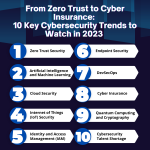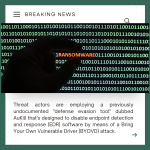As we look ahead to 2023, there are several key cybersecurity trends to watch, from the growing popularity of the Zero Trust security model to the rise of cyber insurance.
Zero Trust Security
Zero Trust is a security model that assumes that every user and device attempting to access a network is a potential threat. This model requires strict authentication and access controls to prevent unauthorized access to sensitive data. With the increasing number of cyber threats, businesses are realizing the importance of Zero Trust security, and it's predicted that the trend will continue to grow in 2023.
Artificial Intelligence (AI) and Machine Learning (ML)
Artificial intelligence and machine learning are becoming increasingly important in cybersecurity. These technologies can help detect and prevent cyber attacks by analyzing vast amounts of data and identifying patterns that indicate suspicious behavior. In 2023, we can expect to see increased adoption of AI and ML-powered cybersecurity solutions.
Cloud Security
Cloud computing has become a vital component of modern business operations, but it also poses unique security challenges. Cloud security solutions are expected to become more sophisticated in 2023, with an increased focus on protecting data in multi-cloud environments and ensuring compliance with industry regulations.
Internet of Things (IoT) Security
The Internet of Things refers to the interconnected network of devices, sensors, and machines that communicate with each other over the Internet. With the rise of smart homes and cities, the number of IoT devices is expected to increase significantly in the coming years. As such, IoT security is becoming a growing concern, and we can expect to see increased investment in IoT security solutions in 2023.
Identity and Access Management (IAM)
Identity and access management (IAM) solutions are becoming increasingly important in preventing data breaches. IAM solutions help ensure that only authorized users can access sensitive data, and they're expected to become more sophisticated in 2023, with an increased focus on user behavior analytics and machine learning-based threat detection.
Endpoint Security
Endpoints are the devices used to access a network, such as laptops, smartphones, and tablets. Endpoint security solutions protect these devices from cyber attacks, and they're expected to become more advanced in 2023, with an increased focus on behavior-based detection and response.
DevSecOps
DevSecOps is the practice of integrating security into the software development process. This approach helps ensure that security is a key consideration from the very beginning of the software development lifecycle. DevSecOps is expected to become increasingly important in 2023, as businesses look for ways to minimize the risk of vulnerabilities in their software.
Cyber Insurance
Cyber insurance is becoming an essential component of cybersecurity risk management. This type of insurance provides financial protection in the event of a data breach or cyber attack. In 2023, we can expect to see increased demand for cyber insurance, as businesses seek to protect themselves from the financial consequences of cyber incidents.
Quantum Computing and Cryptography
Quantum computing is a rapidly developing technology that could have significant implications for cybersecurity. Quantum computers can perform complex calculations much faster than traditional computers, potentially making current encryption methods vulnerable. As such, there's a growing focus on developing quantum-resistant cryptography, and this trend is expected to continue in 2023.
Cybersecurity Talent Shortage
There's currently a shortage of skilled cybersecurity professionals, and this trend is expected to continue in 2023. As the demand for cybersecurity expertise grows, businesses will need to find new ways to attract and retain top talent, such as offering competitive salaries and benefits, providing opportunities for professional development, and fostering a positive workplace culture. Companies may also consider partnering with educational institutions to offer internships and mentorship programs to help train the next generation of cybersecurity professionals.
In conclusion, the cybersecurity landscape is constantly evolving, and it's essential to stay informed about the latest trends and developments. From the Zero Trust security model to the rise of cyber insurance, the cybersecurity trends we can expect to see in 2023 will have a significant impact on how individuals, businesses, and governments protect their sensitive data. By investing in the latest cybersecurity solutions and staying up-to-date on the latest threats, we can all help ensure a safer and more secure digital future.








